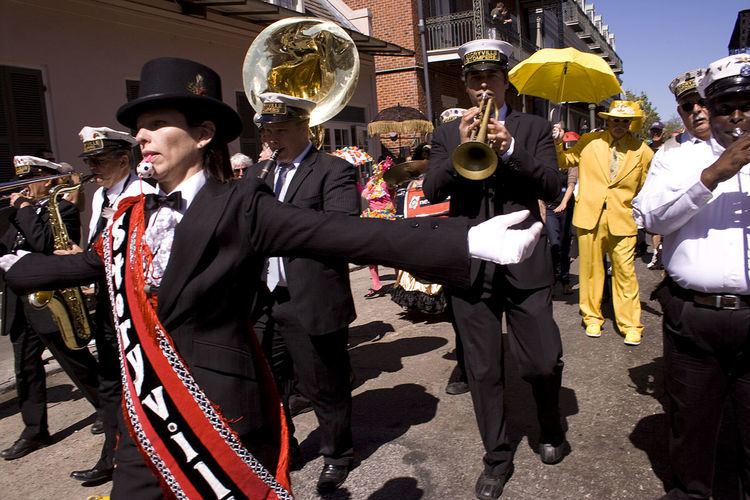 | ||
Second line is a tradition in brass band parades in New Orleans, Louisiana. The "main line" or "first line" is the main section of the parade, or the members of the actual club with the parading permit as well as the brass band. Those who follow the band just to enjoy the music are called the "second line." The second line's style of traditional dance, in which participants walk and sometimes twirl a parasol or handkerchief in the air, is called "second lining." It has been called "the quintessential New Orleans art form – a jazz funeral without a body." Another significant difference from so called "jazz funerals" is second line parades usually lack the slow hymns and dirges played at funerals (although this is not a hard rule; some organizations may have the band play something solemn towards the start of the parade in memory of members deceased since their last parade).
Contents
Origins
Some scholars believe that second lining has its origins in traditional West African circle dances, where children formed a periphery circle outside the main circle of adult dancers. The dance was brought by slaves to New Orleans, where it became incorporated into processions, such as funerals, forcing the ring to straighten into a line. Others note the similarity of the steps – exaggerated, loosely coordinated strutting – to dances performed in Congo Square by the enslaved given the day off on Sundays. These dances were officially banned for a time because they were deemed threatening to the white inhabitants of the city, and their resurgence in second lining suggests a similar celebration of individual freedom.
After the Civil War, African and African-American traditions came to be merged with the military brass band parade traditions of the Europeans and white Americans. Insurance companies often refused to cover the recently freed formerly enslaved, so African Americans formed into Benevolent Societies and "Social Aid & Pleasure Clubs". Membership benefits usually included a brass band for funerals and at least one public parade with music a year, so such societies became important in establishing the second line traditions.
The Second Line – the magazine of the New Orleans jazz club, started in 1950 – took its name from the second lining tradition, which by that time included fans of jazz music, both black and white.
Second-line Drumming
A second-line snare drummer commonly follows the brass band, playing off of the marching beat with improvised polyrhythmic figures that can inspire second line dancers or, if the band is improvising, the band itself. Second-line drumming styles became a feature of early jazz drumming and the New Orleans Rhythm and Blues of the 1950s. The Rebirth Brass Band and the Dirty Dozen Brass Band feature traditional second-line drumming styles. Idriss Muhammed adapted second-line drum figures to modern jazz.
Modern second lining
Second line parades are part of the cultural heritage of New Orleans.
The locally best known second line parades are held by clubs and benevolent organizations. Some have long histories; the oldest such organization still holding regular parades is the Young Men Olympian Junior Benevolent Association, founded in 1884. During the "second line season", lasting most of the year with breaks for holidays (including Mardi Gras) and the hottest part of summer, there are second line parades most Sundays. Longer parades often make stops, commonly at bars, where refreshments have been arranged for members and those following the parade for fun can purchase something. There are often vendors selling soft drinks, beer, and street food, including barbecue and yaka mein.
Additional second lines, large or small, may be held for any event which people think merits hiring a parading band for such a style of celebration, including weddings and opening of businesses.
The historic predominantly African-American neighborhoods of Tremé and Central City are most strongly associated with the traditions, though second lines can often be seen in the Seventh Ward, Uptown, Marigny, Ninth Ward, Mid-City, and at least on occasion in most of the older neighborhoods of the city. The New Orleans Jazz & Heritage Festival holds second lines at the Fair Grounds each day of the festival to give visitors a taste of this New Orleans tradition.
Historically, the parades were unofficial events and had an air of menace. A second line parade was featured in the 1973 James Bond film Live and Let Die. Later, the opening episode (as well as the last one of the first season) of the HBO series Tremé featured a second line parade and journalists championed second line culture. After Hurricane Katrina, new residents of New Orleans embraced the second line tradition and it became part of the cultural economy of the city. Parade routes were publicized online inviting outsiders to participate.
The overwhelming majority of second line events have been peaceful, but like any other public event where large numbers of people gather, violence has marred some parades in recent years, most notoriously in the gang-related May 12, 2013 Mother's Day Parade shooting where 19 were wounded and one trampled, and again on November 22, 2015, at Bunny Friend Park, where 17 were wounded, three critically.
Other places
Though originally a New Orleans phenomenon, in recent times the style has spread to other parts of the country; the HONK! Festival in Somerville, MA, was started by The Second Line Social Aid and Pleasure Society Brass Band. Asheville, North Carolina has the "Asheville Second Line Band", which marches at parades and other events in Asheville. Still, second lining remains most common in the New Orleans area.
